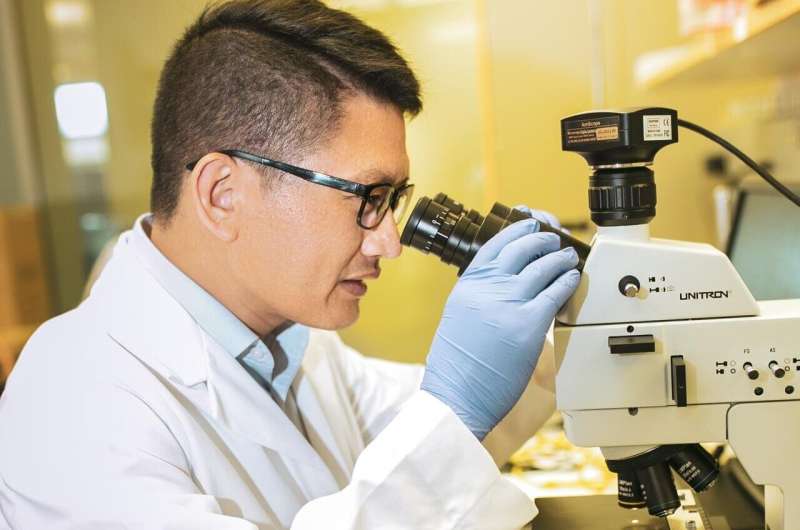'Climbing droplets' could lead to more efficient water harvesting

University of Texas at Dallas researchers have discovered that a novel surface they developed to harvest water from the air encourages tiny water droplets to move spontaneously into larger droplets.
When researchers placed microdroplets of water on their liquid-lubricant surface, the microdroplets propelled themselves to climb, without external force, into larger droplets along an oily, ramp-shaped meniscus that forms from the lubricant around the larger droplets. The "coarsening droplet phenomenon" formed droplets large enough for harvesting.
"This meniscus-mediated climbing effect enabled rapid coalescence on hydrophilic surfaces and has not been reported before. We have discovered a new physical phenomenon that makes it possible to harvest water more rapidly from air without external force," said Dr. Xianming Dai, assistant professor of mechanical engineering in the Erik Jonsson School of Engineering and Computer Science, who led the work. "If we don't have this new phenomenon, the droplets would be too small, and we could hardly collect them."
Microdroplets of water on a hydrophilic SLIPS surface (left) propel themselves to climb, without external force, into larger droplets along an oily, ramp-shaped meniscus that forms from the lubricant around the larger droplets. On the right, the video clip shows how microdroplets behave on a solid slippery surface.
The findings, published March 25 in Cell Reports Physical Science, could solve key problems in harvesting water from air. Many droplets that condense from water vapor in the air are too small to be collected, and they can cover a surface in a way that impedes further condensation.
Developing new technologies that harvest water from the atmosphere is a growing field of research as more and more people live in areas where fresh water is in short supply. Scientists estimate that 4 billion people live in regions with severe freshwater shortages for at least one month each year. This number is predicted to rise to between 4.8 billion and 5.7 billion by 2050. Reasons include climate change, polluted water supplies and increased demand due to both population growth and changes in usage behavior.
The key to the microdroplet's self-climbing action is a surface that Dai and his colleagues previously developed. Their liquid lubricant, a hydrophilic slippery liquid-infused porous surface (SLIPS), has a unique hydrophilic nature for water harvesting and rapidly directs water droplets into reservoirs.
Researchers discovered the self-propelling droplet phenomenon on their surface by accident. They were testing different lubricants to determine which could best facilitate water harvesting when they saw the smaller water droplets propel themselves into larger droplets. That led them to collaborate with Dr. Howard A. Stone, chair of mechanical and aerospace engineering at Princeton University and an expert in fluid dynamics, to investigate the underlying physics of the phenomenon.
"Dr. Dai and his team led this work. The ideas are creative, and they made a series of observations in the laboratory that allowed them to understand the underlying physics and its potential applications," Stone said. "They reached out to me to discuss the mechanism, and we had several Skype or Zoom meetings and email exchanges. It was all very interesting and stimulating. I enjoyed very much seeing the ideas evolve into the published paper."
As water vapor condenses on the liquid-lubricant surface, oil from the lubricant forms a meniscus, or curvature, around the droplets. The meniscus looks like an upward-curving ramp, which acts like a bridge along which microdroplets spontaneously climb toward and coalesce with larger water droplets, a process the researchers call the coarsening effect. The properties of the lubricated surface prevent the water droplets from being completely submerged in the oil, so they can float on the oil, allowing them to climb.
"The oil meniscus acts like a bridge, so the droplet can climb on it," Dai said. "The small droplet actively looks for a larger one. After they are connected by the bridge, they become one."
As tiny water droplets condense from air on a cooled surface, they become thermal barriers that prevent further condensation. By allowing for rapid water droplet collection, the coarsening droplets help clear surfaces for new droplets to form, which facilitates faster, more efficient water harvesting.
The self-propelled coarsening droplet on hydrophilic SLIPS shows rapid removal of condensed submicrometer-sized droplets regardless of how the surface is oriented, which presents a promising approach compared to other surfaces used for water harvesting.
"We cannot harvest a large amount of water unless we have a rapid harvesting process. The problem with other surfaces is that the small water droplets may evaporate before they can be harvested," Dai said.
"Based on our experimental data, the coarsening surface enhanced the water harvesting rate 200% higher than its counterparts," said Zongqi Guo, a mechanical engineering doctoral student and co-lead author.Dai and his colleagues continue to work on ways to use their lubricant to make sustainable water harvesting systems that are mobile, smaller in size, lower in weight and less expensive.
"If we can do that, we can harvest water anywhere that has air, which is particularly important in regions where water is scarce," Dai said.
More information: Zongqi Guo et al, Hydrophilic slippery surface enabled coarsening effect for rapid water harvesting, Cell Reports Physical Science (2021). DOI: 10.1016/j.xcrp.2021.100387
Provided by University of Texas at Dallas





















